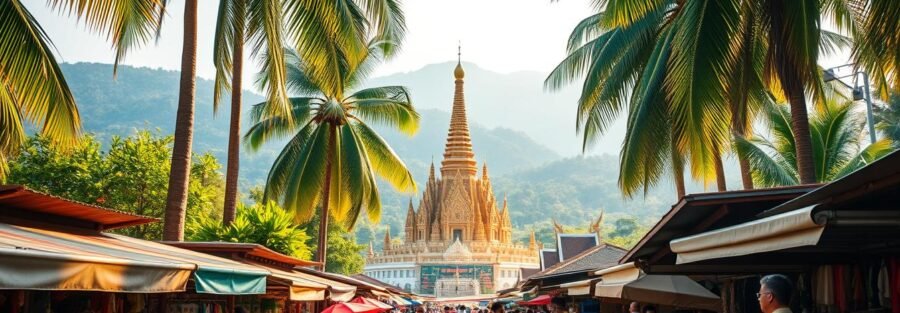Thailand’s reputation as Southeast Asia’s crown jewel isn’t an accident. From misty mountain trails to turquoise bays dotted with limestone cliffs, this country packs more into one trip than most destinations manage across continents. Its nickname, “Land of Smiles,” reflects a culture built on warmth and hospitality. Traits that turn first-time visitors into lifelong fans.
Planning a journey here requires strategy. The north’s rugged hills and tribal villages contrast sharply with the south’s palm-fringed islands. Central plains hide ancient temples beside bustling cities, while the northeast serves up fiery cuisine and rural charm. Trying to cram it all into seven days? Don’t. This guide prioritizes depth over checklist tourism.
I’ve navigated overcrowded itineraries and underwhelming shortcuts so you won’t have to. You’ll get a curated mix of street food hotspots, hidden beaches, and cultural gems. No fluff, no tourist traps. Just clear advice on maximizing your time without sacrificing relaxation or authenticity.
Key Takeaways
- Thailand’s four regions offer distinct adventures: beaches in the south, mountains in the north, history in central plains, and bold flavors in the northeast.
- Balance your days between exploration and downtime to avoid burnout.
- Street food isn’t just affordable, it’s where you’ll taste the country’s soul.
- Skip generic tours; focus on experiences that align with your interests.
- Prioritize locally-owned stays for richer cultural connections.
Overview of a One Week Thailand Itinerary
Crafting the perfect trip requires understanding what seven days can realistically deliver. Attempting to cover every region turns vacations into marathons. Focus on quality over quantity—pick two hubs and dive deep into their surroundings.

Setting Expectations for Your Adventure
First-timers often underestimate travel times between destinations. Flights between Bangkok and Phuket take 90 minutes, but airport transfers eat half a day. I’ve learned through missed connections: three full days per location lets you explore without rushing.
| Rushed Itinerary | Focused Itinerary |
|---|---|
| 4+ cities in 7 days | 2-3 base locations |
| 6+ hours daily in transit | 1-2 travel days total |
| Surface-level experiences | Authentic local interactions |
Key Highlights and Must-Visit Spots
Prioritize these essentials for maximum impact:
- Bangkok’s Grand Palace: Allocate 3 hours minimum
- Phang Nga Bay: Kayak through sea caves at dawn
- Chiang Mai Night Markets: Street food meets craftsmanship
Trust me, you’ll remember a sunset cruise through limestone karsts longer than another rushed temple photo stop. Build buffer time into your days. Thailand rewards those who linger.
Diverse Destinations: Exploring Bangkok, Phuket, and Krabi
Thailand’s magic lies in its contrasts; skyscrapers tower over golden temples, while jungle-covered islands rise from turquoise seas. Three places form the backbone of an ideal week: Bangkok’s electric energy, Phuket’s island rhythm, and Krabi’s raw natural beauty.

Cultural Capitals and Coastal Escapes
Bangkok isn’t just a city, it’s sensory overload perfected. Start at Wat Arun at sunrise before the crowds hit. By afternoon, lose yourself in Chatuchak Market’s 15,000 stalls. Nightfall? Street food carts near Yaowarat Road serve pad kra pao that’ll redefine spicy basil chicken for you.
Phuket works best as your launchpad. Its airport connects globally, but the real value lies offshore. Book a private longtail boat to Freedom Beach, you’ll skip the packed group tours. Developed doesn’t mean ruined; Patong’s chaos contrasts with Cape Panwa’s serenity.
Krabi delivers what postcards promise. Railay Beach’s limestone cliffs attract climbers, while Phi Phi Islands showcase beaches that glow at dusk. For something different, kayak through Thung Teao Forest’s emerald water; it’s like paddling through liquid jade.
Chiang Mai enthusiasts might protest its exclusion, but here’s why this trio wins: Bangkok feeds your curiosity, Phuket simplifies logistics, and Krabi reminds you why you traveled here. Want history? Swap a beach day for Chiang Mai’s temples. Just know you’re trading white sand for mountain air.
Experiencing Thailand’s Rich Culture and History
Thailand’s cultural tapestry weaves golden spires with steaming street carts, ancient rituals with modern energy. To engage authentically, you’ll need more than a guidebook, you need cultural fluency.

Temples, Museums, and Historical Landmarks
The Grand Palace isn’t a museum, it’s a beating heart of Thai identity. Arrive early to watch monks chant at Wat Phra Kaew, home to the sacred Emerald Buddha. Three blocks away, Wat Pho’s 150-foot Reclining Buddha reminds visitors: “This isn’t just art. It’s devotion.”
| Tourist Approach | Cultural Traveler Approach |
|---|---|
| Snapping photos of temple roofs | Observing silent prayer rituals |
| Bargaining at souvenir stalls | Learning wai greeting etiquette |
| Rushing to next attraction | Joining alms-giving at dawn |
Local Markets and Traditional Festivals
Chatuchak Weekend Market’s 11,000 stalls reveal Thailand’s soul. Follow locals to Section 23 for handwoven silk, then grab a street-grilled squid skewer. Night markets like Rot Fai Train offer more than shopping, they’re stages for life unfolding.
Remember: pointing feet at Buddha images insults the culture. Remove shoes before temple entries, dress modestly, and never touch a Thai person’s head. These things matter more than any souvenir.
Culinary Journey: Thai Street Food and Fine Dining
Thai cuisine doesn’t just feed you; it rewires your palate. Forget what you know about takeout containers back home. Here, every bite tells a story of chili-fired passion and coconut-kissed tradition.

Iconic Dishes and Hidden Eateries
Street stalls are Thailand’s food laboratories. A sizzling wok at 7 AM means someone’s perfecting khao tom (rice soup) for 35 baht. I’ve watched masters flip pad see ew noodles for 30 years straight. These aren’t vendors, they’re flavor architects.
Three rules for eating safely:
- Follow the queue: Locals vote with their feet—busy stalls stay in business
- Watch the cook: Fresh ingredients hit the pan as you order
- Skip the ice: Stick to sealed bottles or coconut water
Regional gems outshine tourist traps. Hunt som tam (papaya salad) in Isaan stalls where chili counts hit double digits. Northern restaurants serve khao soi, crispy noodles drowning in curry, for 60 baht. This is where flavors dance.
| Street Food | Fine Dining |
|---|---|
| 35-100 baht per meal | 1,500-3,000 baht tasting menus |
| Plastic stools, shared tables | Rooftop views, linen napkins |
| Instant feedback loop (no customers = no business) | Michelin stars and molecular gastronomy |
Yes, you can splurge. Bangkok’s restaurants like Gaggan Anand reinvent curry through science, but remember: that 2,000-baht dish won’t taste better than the 40-baht guay teow noodle soup that fueled your market crawl.
Island Adventures and Stunning Beaches
Thailand’s coastlines hide more secrets than any guidebook can capture. The real challenge? Choosing which islands deserve your limited time. Some spots deliver cinematic views but swarm with tourists, while others trade fame for raw authenticity.

Exploring Phi Phi, Koh Yao Noi, and Beyond
Phi Phi Islands live up to their reputation; turquoise water framed by jagged cliffs. But arrive before 9 AM or stay overnight. Day-trippers vanish at sunset, leaving the beach silent except for lapping waves. Maya Bay’s iconic sand now has visitor limits; book permits early.
Koh Yao Noimoves at fishing village pace. No 7-Elevens here, just stilted bungalows and squid farms. Ferries from Krabi take 40 minutes, making it ideal for travelers who hate long boat rides. Locals rent motorbikes for exploring hidden coves most tourists miss.
Sunsets, Snorkeling, and Relaxation Spots
Railay’s limestone cliffs attract climbers, but its west-facing beaches host Thailand’s most dramatic sunsets. For snorkeling, Bamboo Island’s shallow reefs teem with parrotfish. Avoid midday crowds; most boat tours leave by 3 PM.
Monsoon seasons matter. November-April brings calm seas for island hopping. May-October? Stick to Gulf islands like Koh Samui. Smart travelers split time: two days at Phi Phi for photos, three on quieter islands to recharge.
Accommodation Options: From Budget Hostels to Luxury Resorts
Your hotel choice determines whether you wake up to temple bells or waves crashing. I’ve slept in bamboo huts and infinity pool villas; here’s what works.

Bangkok rewards strategic picks. Sukhumvit Road hotels put you near skytrain access, while riverside stays offer sunset views of Wat Arun. Budget travelers thrive in Silom’s hostels with rooftop pools.
Staying in Bangkok and Coastal Retreats
Phuket splits personalities. Patong’s neon-lit hotels cater to party crowds, but Old Town’s heritage homes-turned-boutique stays ooze charm. Krabi offers three distinct zones:
- Ao Nang: Beachfront hotels steps from longtail boats
- Krabi Town: Budget rooms near night markets
- Railay: Luxury resorts with private beach access
Railay’s prices climb steeply, but you’re paying for cliffs that block all traffic noise. For true uniqueness, Khao Sok’s floating raft houses let you fall asleep to gibbon calls. Pro tip: Pack a dry bag as your “room” sits directly on the lake.
| Area | Best For | Price Range |
|---|---|---|
| Bangkok Sukhumvit | Business travelers | $50-$300/night |
| Phuket Old Town | Cultural immersion | $25-$150/night |
| Railay Beach | Luxury seekers | $150-$800/night |
Remember: A $12 hostel dorm near BTS beats a $80 hotel requiring $10 daily taxi rides. Location trumps thread count here.
Navigating Thailand: Transportation and Travel Tips
Smart transit choices here mean more time exploring and less time commuting. Thailand’s network of planes, buses, and boats runs like clockwork, if you know how to hack it.

Air, Bus, and Taxi Options
Book domestic flights for trips over 300 miles. Bangkok to Phuket takes 90 minutes by air versus 13 hours by bus. Use 12GoAsia to compare tickets; Nok Air often undercuts Bangkok Airways by 40%.
Buses shine for shorter journeys. The 3-hour ride from Chiang Mai to Pai costs $3 and winds through mountain passes you’d miss at 30,000 feet. Night buses? Skip them unless you enjoy arriving at 4 AM.
- Grab beats taxis: Fixed fares prevent meter scams
- MRT/BTS in Bangkok: Buy rabbit cards at stations
- Ferry hacks: Krabi to Phi Phi takes 90 minutes; book online to avoid touts
| Transport | Best For | Cost |
|---|---|---|
| Flights | North-South routes | $30-$80 |
| Buses | Regional day trips | $2-$15 |
| Grab | City navigation | $1.50-$5 |
Pro tip: Always carry cash for boat transfers. Card readers “malfunction” conveniently on remote piers. Your travel rhythm depends on mastering these details.
Hidden Gems and Off the Beaten Path Experiences
True discovery happens when you step beyond the guidebook routes. Thailand’s wild heart beats strongest in places where tour buses don’t park and selfie sticks stay packed.
Local Neighborhood Discoveries
Khao Sok National Park shelters one of the world’s oldest rainforests. Limestone cliffs tower above emerald lakes, kayak silently to spot hornbills and gibbons. For ethical elephant encounters, skip riding camps. The Elephant Nature Park near Chiang Mai lets you feed rescued giants while funding conservation.
Northern villages like Mae Kampong reveal traditions untouched by mass tourism. Learn weaving from Hmong artisans or share sticky rice with Karen people. The Mae Hong Son Loop packs 1,864 curves through mountain vistas—rent a motorbike and stop at hot springs.
Koh Lipe’s castaway vibe lingers if you avoid peak season. Snorkel coral reefs at sunrise, then devour grilled squid at Walking Street. These experiences won’t trend on Instagram. That’s the point.
Smart travelers balance iconic sights with hidden activities. Book a tour with Tribal Voice Asia in Chiang Mai—they funnel profits directly to hill tribes. Or camp under Jurassic-era cliffs in Khao Sok. The world rushes; Thailand’s secrets wait for those who wander.
FAQ
How do I balance city exploration and beach time in 7 days?
Split your trip between Bangkok (2 days) and coastal areas like Phuket or Krabi (5 days). Hit Grand Palace and Chatuchak Market first, then fly south for Phi Phi Islands boat tours and Railay Beach cliffside relaxation.
What’s the best way to experience authentic Thai street food safely?
Stick to busy stalls with high turnover like Jay Fai in Bangkok for her Michelin-starred crab omelets. Avoid raw veggies washed in tap water. Carry probiotics and focus on cooked dishes like pad see ew or tom yum soup.
Are luxury resorts worth the cost compared to budget stays?
Depends on your priorities. The Siam Hotel in Bangkok offers river views and private tours, while Lub d hostels provide social vibes. In Krabi, Rayavadee’s cave suites justify splurging for direct beach access and privacy.
How reliable are domestic flights for island hopping?
Bangkok Airways and AirAsia run frequent 90-minute flights from DMK to Phuket. Book early for – tickets. Always pad your schedule – afternoon thunderstorms sometimes delay routes to Koh Samui or Krabi.
What cultural norms should I know before visiting temples?
A> Cover shoulders/knees at Wat Arun and Wat Pho. Remove shoes before entering prayer areas. Don’t point feet toward Buddha statues. Carry ฿100 bills for donation boxes – the 46-meter reclining Buddha deserves proper respect.
Can I see elephants ethically during a short trip?
Skip riding camps. Elephant Nature Park near Chiang Mai offers day trips from Bangkok via flight+van. Observe herds bathing in rivers without direct interaction. Morning visits beat crowds and midday heat.
What’s the ideal budget for mid-range travelers?
-0/day covers 3-star hotels, local transport, street eats, and tours. Exclude flights. Night trains from Bangkok to Chiang Mai save on accommodation. Haggle at floating markets – 30% off initial prices is standard.
How do I avoid tourist traps at Phi Phi Islands?
Book early speedboats through Andaman Wave Masters to reach Maya Bay before 10 AM crowds. Skip the Viking Cave souvenir shops – snorkel at Bamboo Island instead. Sleep on Koh Yao Noi for quieter sunsets.



